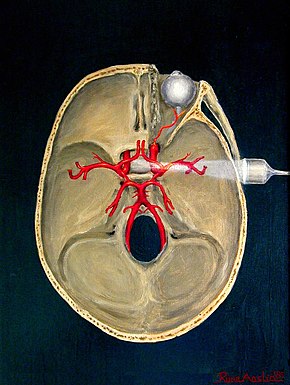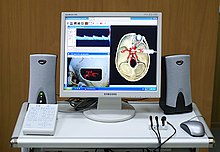| Transcranial Doppler | |
|---|---|
 Transcranial Doppler insonation of the cerebral circulation | |
| Synonyms | Transcranial color Doppler |
| ICD-9-CM | 88.71 |
| MeSH | D017585 |
| LOINC | 24733-8, 39044-3, 30880-9 |

Transcranial Doppler (TCD) and transcranial color Doppler (TCCD) are types of Doppler ultrasonography that measure the velocity of blood flow through the brain's blood vessels by measuring the echoes of ultrasound waves moving transcranially (through the cranium). These modes of medical imaging conduct a spectral analysis of the acoustic signals they receive and can therefore be classified as methods of active acoustocerebrography. They are used as tests to help diagnose emboli, stenosis, vasospasm from a subarachnoid hemorrhage (bleeding from a ruptured aneurysm), and other problems. These relatively quick and inexpensive tests are growing in popularity.[citation needed] The tests are effective for detecting sickle cell disease, ischemic cerebrovascular disease, subarachnoid hemorrhage, arteriovenous malformations, and cerebral circulatory arrest. The tests are possibly useful for perioperative monitoring and meningeal infection.[1] The equipment used for these tests is becoming increasingly portable, making it possible for a clinician to travel to a hospital, to a doctor's office, or to a nursing home for both inpatient and outpatient studies. The tests are often used in conjunction with other tests such as MRI, MRA, carotid duplex ultrasound and CT scans. The tests are also used for research in cognitive neuroscience (see Functional transcranial Doppler, below).
- ^ "Transcranial Doppler: An Overview of its Clinical Applications". Archived from the original on April 25, 2015. Retrieved June 3, 2013.